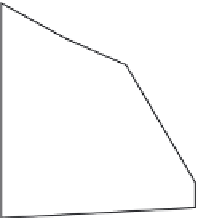Geoscience Reference
In-Depth Information
After strong drying of the soil and the accompanying micro-
structural reorganization, hydrophobic properties appear so that
complete rewetting at a later stage is impossible.
The plant-available water (approximately corresponding to pF 3
to pF 4.2) is only just adequate and is moved towards high water
contents.
Iv = Vv/Vs
H%= 100(Vw/Vs)
250
5
Vair
200
4
150
3
Vw
2
100
1
50
6
1
Vs
pF
4.2
Fig. 10.9
Volume of solid (Vs) and variation according to water tension of: volume of water
(Vw), volume of air (Vair), void Index [Iv = (Vw+Vair)/Vs] and water content in % (H%) in an
Andosol of Reunion (Rosello 1984).
We know that by starting from a dry soil and adding water according
to a well-defined protocol the
plastic limit
is reached (the soil becomes
a paste) and then the
liquid limit
(the mixture flows). These two limits
are particularly close to one another in Andosols (Arnalds
et al
. 1995).
On slopes, heavily saturated Andosols often yield to mass movements
prejudicial to human populations. Not to be entirely confused with
lahars
, mudflows are also destructive, caused by the carrying away of
recently deposited volcanic ash by heavy rain (FAO 2006).
Overall, Andosols are not susceptible to compaction, when dry or
when wet, because of the resistance of their constituent aggregates.
Mechanical properties
The permeability varies with the state of the soil. When very dry, it is
zero and water does not pass through (hydrophobic character). When
the soil is moist, permeability is often high, depending on the presence
of large pores. Movement of water also takes place through capillarity
in the fine pores.
Permeability






































































